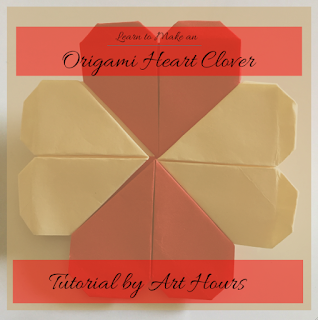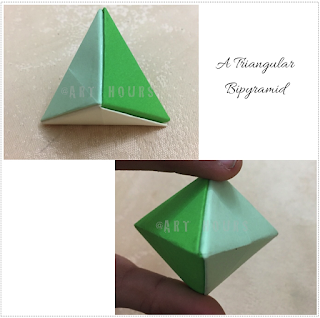Looking for last minute ideas for Handmade gifts or decorations for this Valentine's?
You have landed on the right page...Through this post today, you will learn to fold an origami Heart Clover that you can use to make decorations for cards, gift toppers and more...
Category: Modular Origami
Level of difficulty: On a scale of 5, I would give it a 3.
Below is a picture tutorial, followed by a written step by step explanation, that will guide you to make this model.
Material used:
8.75cm x 8.75cm square sheets cut out from the printer paper. Requires 4 such square units. You can use any square sized sheets depending upon the requirement.
Procedure:
Steps to follow as per the picture above for making the Clover unit.
If you are using a two-sided different colored paper, start with white side on the top and proceed with the instructions in the same way.
 |
| Heart Clover Unit |
Instructions to make the Heart Clover Unit:
- Fold in half along the centers to make the horizontal and vertical creases and then open it. Note the hidden lines for the fold in the next step.
- Fold in as shown.
- Turn over and note the hidden lines for the next fold.
- Fold along the hidden lines to meet at the centre.
- Turn over and note the hidden lines to make the next fold.
- Fold along the hidden lines.
- Now focus on the upper part of the unit. Squash open the folds and fold as shown.
- Note the hidden lines for the next fold.
- Fold in both the sides along the hidden lines to meet at the centre.
- Fold in the top triangles along the indicated hidden lines.
- Turn over and one heart unit is ready.
 |
| Heart Clover Model Assembly |
Instructions to assemble the model:
- Follow the instructions above and make a total of 4 units.
- Insert units one by one, below each other as shown in the picture above and glue them. The heart clover model is ready.
You can use this origami model to make greeting cards or decorate the gifts by using them as gift toppers and gift them to your dear and near ones this Valentine's season. Your friends will love receiving gifts made by hand and if it is such a pretty thing, your efforts will surely be appreciated.
Hope this tutorial inspires you to make many such beautiful origami models.
Thank you for stopping by.
Have a nice day ahead and... yes...wishing you all a very Happy Valentine's Day.
Keep folding and spreading peace and love.
---









